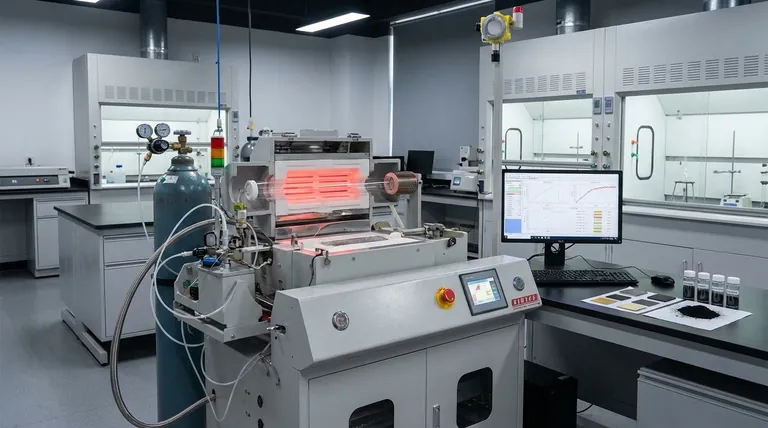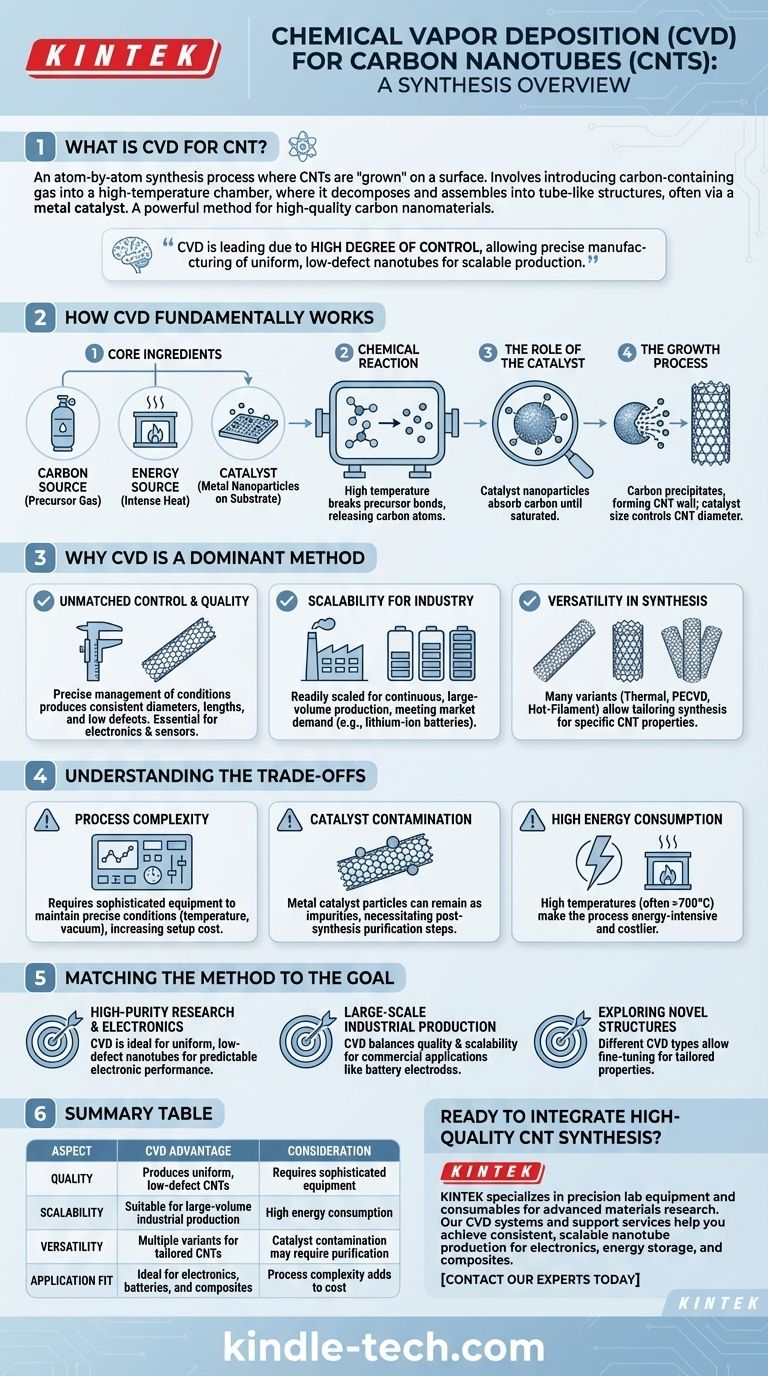In essence, Chemical Vapor Deposition (CVD) for carbon nanotubes (CNTs) is a synthesis process where CNTs are "grown" atom-by-atom on a surface. It involves introducing a carbon-containing gas into a high-temperature vacuum chamber, where the gas decomposes and the carbon atoms assemble into the tube-like structures of CNTs, often with the help of a metal catalyst. This method is one of the most common and powerful techniques for producing high-quality carbon nanomaterials.
The core reason CVD has become a leading method for CNT synthesis is its high degree of control. Unlike other methods, CVD allows for the precise manufacturing of uniform, low-defect nanotubes, making it uniquely suitable for scaling up production for high-performance electronics and industrial applications.

How CVD Fundamentally Works
To understand CVD, it's best to think of it as a highly controlled construction process on a microscopic scale. It relies on a specific chemical reaction in a controlled environment.
The Core Ingredients
The process requires three key components: a carbon source, an energy source, and a catalyst. The carbon source is a volatile precursor gas (like methane or acetylene), the energy is typically intense heat, and the catalyst consists of nanoparticle metals (like iron or nickel) on a substrate.
The Chemical Reaction
Inside the reaction chamber, the high temperature provides the energy needed to break the chemical bonds of the precursor gas. This thermal decomposition releases carbon atoms, making them available for construction.
The Role of the Catalyst
The freed carbon atoms are absorbed by the metal catalyst nanoparticles. Once the catalyst becomes saturated with carbon, the carbon atoms begin to precipitate out in an organized, cylindrical lattice structure, forming the wall of a carbon nanotube.
The Growth Process
The nanotube continues to lengthen as more carbon atoms are fed through the catalyst particle. The diameter of the nanotube is directly controlled by the size of the catalyst particle from which it grows, allowing for remarkable precision.
Why CVD is a Dominant Method
While other methods like laser ablation and arc-discharge exist, CVD has become the preferred choice for many modern applications due to several distinct advantages.
Unmatched Control and Quality
The primary advantage of CVD is control. By precisely managing temperature, pressure, and gas flow, manufacturers can produce CNTs with consistent diameters, lengths, and minimal structural defects. This high quality is critical for demanding applications in electronics and sensors.
Scalability for Industry
CVD processes are more readily scaled for continuous, large-volume production compared to other methods. This scalability is essential to meet the growing market demand for CNTs, particularly for use in next-generation lithium-ion batteries and advanced composites.
Versatility in Synthesis
There are many variations of CVD, including Thermal CVD, Plasma-Enhanced CVD (PECVD), and Hot-Filament CVD. Each variant offers different benefits, allowing researchers and manufacturers to tailor the synthesis process to produce specific types of CNTs (e.g., single-walled vs. multi-walled).
Understanding the Trade-offs
No method is perfect. Being objective means acknowledging the challenges associated with CVD.
Process Complexity
Achieving the high level of control that makes CVD so powerful requires sophisticated equipment. Maintaining precise conditions (temperature, vacuum, gas purity) adds complexity and cost to the manufacturing setup.
Catalyst Contamination
Because the process relies on metal catalyst particles, these particles can sometimes remain as impurities in the final CNT product. This often necessitates additional purification steps after synthesis, adding time and expense.
High Energy Consumption
The most common form, Thermal CVD, requires very high temperatures, often exceeding 700°C. This makes the process energy-intensive, which can be a significant factor in the overall cost and environmental impact of production.
Matching the Method to the Goal
Choosing the right synthesis approach depends entirely on your end goal. CVD offers a powerful and versatile platform for creating high-grade nanomaterials.
- If your primary focus is high-purity research and electronics: CVD is the leading choice for its ability to produce uniform, low-defect nanotubes essential for predictable electronic performance.
- If your primary focus is large-scale industrial production: CVD provides the best balance of quality and scalability, making it ideal for commercial applications like battery electrodes and advanced polymer composites.
- If your primary focus is exploring novel structures: The versatility of different CVD types allows for fine-tuning the growth process to create CNTs with specific, tailored properties for specialized applications.
Ultimately, mastering Chemical Vapor Deposition is key to unlocking the full potential of carbon nanotubes in next-generation technologies.
Summary Table:
| Aspect | CVD Advantage | Consideration |
|---|---|---|
| Quality | Produces uniform, low-defect CNTs | Requires sophisticated equipment |
| Scalability | Suitable for large-volume industrial production | High energy consumption |
| Versatility | Multiple variants (Thermal, PECVD) for tailored CNTs | Catalyst contamination may require purification |
| Application Fit | Ideal for electronics, batteries, and composites | Process complexity adds to cost |
Ready to integrate high-quality CNT synthesis into your lab workflow? KINTEK specializes in precision lab equipment and consumables for advanced materials research. Our CVD systems and support services help you achieve consistent, scalable nanotube production for electronics, energy storage, and composites. Contact our experts today to explore tailored solutions for your laboratory needs!
Visual Guide

Related Products
- Customer Made Versatile CVD Tube Furnace Chemical Vapor Deposition Chamber System Equipment
- Split Chamber CVD Tube Furnace with Vacuum Station Chemical Vapor Deposition System Equipment Machine
- 1200℃ Split Tube Furnace with Quartz Tube Laboratory Tubular Furnace
- High Pressure Laboratory Vacuum Tube Furnace Quartz Tubular Furnace
- 1700℃ Laboratory Quartz Tube Furnace with Alumina Tube Tubular Furnace
People Also Ask
- How does chirality affect carbon nanotubes? It Determines If They Are Metal or Semiconductor
- What are the methods of producing CNT? Scalable CVD vs. High-Purity Lab Techniques
- What are the challenges of carbon nanotubes? Overcoming Production and Integration Hurdles
- How high of temperature do carbon nanotubes in air have the ability to sustain? Understanding the Oxidation Limit
- What is the floating catalyst method? A Guide to High-Yield CNT Production



















